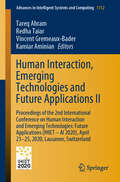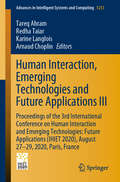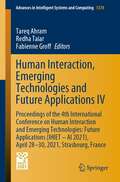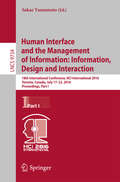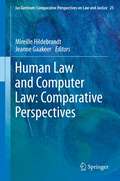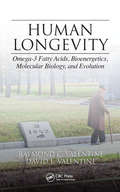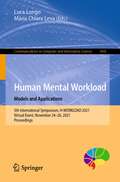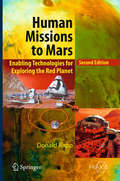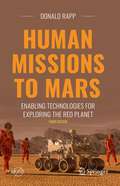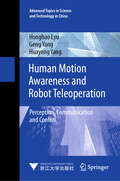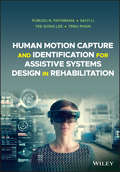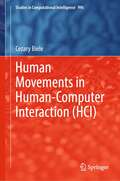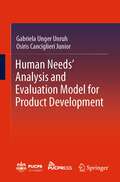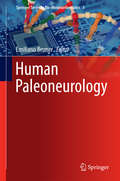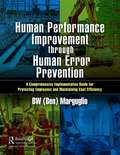- Table View
- List View
Human Interaction, Emerging Technologies and Future Applications II: Proceedings of the 2nd International Conference on Human Interaction and Emerging Technologies: Future Applications (IHIET – AI 2020), April 23-25, 2020, Lausanne, Switzerland (Advances in Intelligent Systems and Computing #1152)
by Tareq Ahram Redha Taiar Vincent Gremeaux-Bader Kamiar AminianThis book reports on research and developments in human-technology interaction. A special emphasis is given to human-computer interaction, and its implementation for a wide range of purposes such as healthcare, aerospace, telecommunication, and education, among others. The human aspects are analyzed in detail. Timely studies on human-centered design, wearable technologies, social and affective computing, augmented, virtual and mixed reality simulation, human rehabilitation and biomechanics represent the core of the book. Emerging technology applications in business, security, and infrastructure are also critically examined, thus offering a timely, scientifically-grounded, but also professionally-oriented snapshot of the current state of the field. The book is based on contributions presented at the 2nd International Conference on Human Interaction and Emerging Technologies: Future Applications, IHIET-AI 2020, held on April 23-25, in Lausanne, Switzerland. It offers a timely survey and a practice-oriented reference guide to researchers and professionals dealing with design and/or management of the new generation of service systems.
Human Interaction, Emerging Technologies and Future Applications III: Proceedings of the 3rd International Conference on Human Interaction and Emerging Technologies: Future Applications (IHIET 2020), August 27-29, 2020, Paris, France (Advances in Intelligent Systems and Computing #1253)
by Tareq Ahram Redha Taiar Arnaud Choplin Karine LangloisThis book reports on research and developments in human-technology interaction. A special emphasis is given to human-computer interaction, and its implementation for a wide range of purposes such as healthcare, aerospace, telecommunication, and education, among others. The human aspects are analyzed in detail. Timely studies on human-centered design, wearable technologies, social and affective computing, augmented, virtual and mixed reality simulation, human rehabilitation and biomechanics represent the core of the book. Emerging technology applications in business, security, and infrastructure are also critically examined, thus offering a timely, scientifically-grounded, but also professionally-oriented snapshot of the current state of the field. The book is based on contributions presented at the 3rd International Conference on Human Interaction and Emerging Technologies: Future Applications, IHIET 2020, held on August 27-29, 2020. It offers a timely survey and a practice-oriented reference guide to researchers and professionals dealing with design and/or management of the new generation of service systems.
Human Interaction, Emerging Technologies and Future Applications IV: Proceedings of the 4th International Conference on Human Interaction and Emerging Technologies: Future Applications (IHIET – AI 2021), April 28-30, 2021, Strasbourg, France (Advances in Intelligent Systems and Computing #1378)
by Tareq Ahram Redha Taiar Fabienne GroffThis book reports on research and developments in human-technology interaction. A special emphasis is given to human-computer interaction, and its implementation for a wide range of purposes such as healthcare, manufacturing, transportation, and education, among others. The human aspects are analyzed in detail. Innovative studies related to human-centered design, wearable technologies, augmented, virtual and mixed reality simulation, as well as developments and applications of machine learning and AI for different purposes, represent the core of the book. Emerging issues in business, security, and infrastructure are also critically examined, thus offering a timely, scientifically-grounded, but also professionally-oriented snapshot of the current state of the field. The book is based on contributions presented at the 4th International Conference on Human Interaction and Emerging Technologies: Future Applications, IHIET-AI 2021, held on April 28-30, 2021, in Strasbourg, France. It offers a timely survey and a practice-oriented reference guide to researchers and professionals dealing with design and/or management of the new generation of service systems.
Human Interaction, Emerging Technologies and Future Systems V: Proceedings of the 5th International Virtual Conference on Human Interaction and Emerging Technologies, IHIET 2021, August 27-29, 2021 and the 6th IHIET: Future Systems (IHIET-FS 2021), October 28-30, 2021, France (Lecture Notes in Networks and Systems #319)
by Tareq Ahram Redha TaiarThis book reports on research and developments in human–technology interaction. A special emphasis is given to human–computer interaction and its implementation for a wide range of purposes such as health care, aerospace, telecommunication, and education, among others. The human aspects are analyzed in detail. Timely studies on human-centered design, wearable technologies, social and affective computing, augmented, virtual and mixed reality simulation, human rehabilitation, and biomechanics represent the core of the book. Emerging technology applications in business, security, and infrastructure are also critically examined, thus offering a timely, scientifically grounded, but also professionally oriented snapshot of the current state of the field. The book gathers contributions presented at the 5th International Conference on Human Interaction and Emerging Technologies (IHIET 2021, August 27–29, 2021) and the 6th International Conference on Human Interaction and Emerging Technologies: Future Systems (IHIET-FS 2021, October 28–30, 2021), held virtually from France. It offers a timely survey and a practice-oriented reference guide to researchers and professionals dealing with design, systems engineering, and management of the next-generation technology and service systems.
Human Interface and the Management of Information. Information in Applications and Services: 20th International Conference, HIMI 2018, Held as Part of HCI International 2018, Las Vegas, NV, USA, July 15-20, 2018, Proceedings, Part II (Lecture Notes in Computer Science #10905)
by Sakae Yamamoto Hirohiko MoriThis two-volume set LNCS 10904 and 10905 constitutes the refereed proceedings of the 20th International Conference on Human Interface and the Management of Information, HIMI 2018, held as part of HCI International 2018 in Las Vegas, NV, USA, in July 2018.The total of 1170 papers and 195 posters included in the 30 HCII 2018 proceedings volumes was carefully reviewed and selected from 4373 submissions.The 53 papers presented in this volume were organized in topical sections named: interacting with information; information and learning; information in aviation and transport; intelligent systems; and sevice management.
Human Interface and the Management of Information: 18th International Conference, HCI International 2016 Toronto, Canada, July 17-22, 2016, Proceedings, Part I (Lecture Notes in Computer Science #9734)
by Sakae YamamotoThe two-volume set LNCS 9734 and 9735 constitutes the refereed proceedings of the Human Interface and the Management of Information thematic track, held as part of the 18th International Conference on Human-Computer Interaction, HCII 2016, held in Toronto, Canada, in July 2016. HCII 2016 received a total of 4354 submissions of which 1287 papers were accepted for publication after a careful reviewing process. These papers address the latest research and development efforts and highlight the human aspects of design and use of computing systems. The papers accepted for presentation thoroughly cover the entire field of human-computer interaction, addressing major advances in knowledge and effective use of computers in a variety of application areas This volume contains papers addressing the following major topics: information presentation; big data visualization; information analytics; discovery and exploration; interaction design, human-centered design; haptic, tactile and multimodal interaction.
Human Law and Computer Law: Comparative Perspectives
by Jeanne Gaakeer Mireille HildebrandtThe focus of this book is on the epistemological and hermeneutic implications of data science and artificial intelligence for democracy and the Rule of Law. How do the normative effects of automated decision systems or the interventions of robotic fellow 'beings' compare to the legal effect of written and unwritten law? To investigate these questions the book brings together two disciplinary perspectives rarely combined within the framework of one volume. One starts from the perspective of 'code and law' and the other develops from the domain of 'law and literature'. Integrating original analyses of relevant novels or films, the authors discuss how computational technologies challenge traditional forms of legal thought and affect the regulation of human behavior. Thus, pertinent questions are raised about the theoretical assumptions underlying both scientific and legal practice.
Human Longevity: Omega-3 Fatty Acids, Bioenergetics, Molecular Biology, and Evolution
by Raymond C. Valentine David L. ValentineMore than 7 billion people inhabit the earth and all of them are subject to aging. This book is aimed at persons interested in a molecular explanation of how our cells age. Human Longevity: Omega-3 Fatty Acids, Bioenergetics, Molecular Biology, and Evolution is built on the proposition that we age as our mitochondria age. It suggests a revised vers
Human Medical Research
by Verena Sandow Jan Schildmann Jochen Vollmann Oliver RauprichMedical research involving human subjects has contributed to considerable advancements in our knowledge, and to medical benefits. At the same time the development of new technologies as well as further globalisation of medical research raises questions that require the attention of researchers from a range of disciplines. This book gathers the contributions of researchers from nine different countries, who analyse recent developments in medical research from ethical, historical, legal and socio-cultural perspectives. In addition to reflections on innovations in science such as genetic databases and the concept of "targeted therapy" the book also includes analyses regarding the ethico-legal regulation of new technologies such as human tissue banking or the handling of genetic information potentially relevant for participants in medical research. Country and culture-specific aspects that are relevant to human medical research from a global perspective also play a part. The value of multi- and interdisciplinary analysis that includes the perspectives of scholars from normative and empirical disciplines is a shared premise of each contribution.
Human Memory and Material Memory
by Christian LexcellentThis book investigates the fascinating concept of a continuum between human memory and memory of materials. The first part provides state-of-the-art information on shape memory alloys and outlines a brief history of memory from the ancient Greeks to the present day, describing phenomenological, philosophical, and technical approaches such as neuroscience. Then, using a wealth of anecdotes, data from academic literature, and original research, this short book discusses the concepts of post-memory, memristors and forgiveness, highlights the analogies between materials defects and memory traces in the human brain. Lastly, it tackles questions of how human memory and memory of materials work together and interact. With insights from materials mechanics, neuroscience and philosophy, it enables readers to understand and continue this open debate on human memory.
Human Mental Workload: 5th International Symposium, H-WORKLOAD 2021, Virtual Event, November 24–26, 2021, Proceedings (Communications in Computer and Information Science #1493)
by Luca Longo Maria Chiara LevaThis book constitutes the refereed proceedings of the 5th International Symposium on Human Mental Workload: Models and Applications, H-WORKLOAD 2021, held virtually in November 2021.The volume presents 9 revised full papers, which were carefully reviewed and selected from 16 submissions. The papers are organized in two topical sections on models and applications.
Human Mental Workload: Third International Symposium, H-WORKLOAD 2019, Rome, Italy, November 14–15, 2019, Proceedings (Communications in Computer and Information Science #1107)
by Luca Longo Maria Chiara LevaThis book constitutes the refereed proceedings of the Third International Symposium on Human Mental Workload: Models and Applications, H-WORKLOAD 2019, held in Rome, Italy, in November 2019.The volume presents one keynote paper as well as 14 revised full papers, which were carefully reviewed and selected from 32 submissions. The papers are organized in two topical sections on models and applications.
Human Missions to Mars
by Donald RappA mission to send humans to explore the surface of Mars has been the ultimate goal of planetary exploration since the 1950s, when von Braun conjectured a flotilla of 10 interplanetary vessels carrying a crew of at least 70 humans. Since then, more than 1,000 studies were carried out on human missions to Mars, but after 60 years of study, we remain in the early planning stages. The second edition of this book now includes an annotated history of Mars mission studies, with quantitative data wherever possible. Retained from the first edition, Donald Rapp looks at human missions to Mars from an engineering perspective. He divides the mission into a number of stages: Earth's surface to low-Earth orbit (LEO); departing from LEO toward Mars; Mars orbit insertion and entry, descent and landing; ascent from Mars; trans-Earth injection from Mars orbit and Earth return. For each segment, he analyzes requirements for candidate technologies. In this connection, he discusses the status and potential of a wide range of elements critical to a human Mars mission, including life support consumables, radiation effects and shielding, microgravity effects, abort options and mission safety, possible habitats on the Martian surface and aero-assisted orbit entry decent and landing. For any human mission to the Red Planet the possible utilization of any resources indigenous to Mars would be of great value and such possibilities, the use of indigenous resources is discussed at length. He also discusses the relationship of lunar exploratio n to Mars exploration. Detailed appendices describe the availability of solar energy on the Moon and Mars, and the potential for utilizing indigenous water on Mars. The second edition provides extensive updating and additions to the first edition, including many new figures and tables, and more than 70 new references, as of 2015.
Human Missions to Mars: Enabling Technologies for Exploring the Red Planet (Springer Praxis Books)
by Donald RappIn this book, Donald Rapp looks at human missions to Mars from a technological perspective. He divides the mission into a number of stages: Earth’s surface to low-Earth orbit (LEO); departing from LEO toward Mars; Mars orbit insertion and entry, descent and landing; ascent from Mars; trans-Earth injection from Mars orbit and Earth return.A mission to send humans to explore the surface of Mars has been the ultimate goal of planetary exploration since the 1950s, when von Braun conjectured a flotilla of 10 interplanetary vessels carrying a crew of at least 70 humans. Since then, more than 1,000 studies were carried out. This third edition provides extensive updating and additions to the last edition, including new sections, and many new figures and tables, and references.
Human Missions to Outer Space: A True Book: Space Exploration (A True Book (Relaunch))
by Laurie CalkhovenFrom the first time a person looked up at the sky and wondered “What’s out there?” humans have dreamed about exploring the cosmos.This book is part of a series A True Book: Space Exploration, that includes the titles Human Missions to Outer Space, Mars Rovers, The International Space Station, and UFO's. The series features the latest NASA imagery and lively text to bring the wonder of space exploration directly to readers.About 60 years ago, the first manned spacecraft left Earth’s atmosphere for the first time. In the years since, astronauts have visited the moon several times—and have spent extended time living in outer space. We even have plans to send humans to Mars by the 2030s! Share in the joy of exploration and discovery with Human Missions to Outer Space.
Human Mobility and Technological Transfer in the Prehistoric Mediterranean: Human Mobility and Technological Transfer In The Prehistoric Mediterranean
by Carl Knappett Evangelia KiriatziThe diverse forms of regional connectivity in the ancient world have recently become an important focus for those interested in the deep history of globalisation. This volume represents a significant contribution to this new trend as it engages thematically with a wide range of connectivities in the later prehistory of the Mediterranean, from the later Neolithic of northern Greece to the Levantine Iron Age, and with diverse forms of materiality, from pottery and metal to stone and glass. With theoretical overviews from leading thinkers in prehistoric mobilities, and commentaries from top specialists in neighbouring domains, the volume integrates detailed case studies within a comparative framework. The result is a thorough treatment of many of the key issues of regional interaction and technological diversity facing archaeologists working across diverse places and periods. As this book presents key case studies for human and technological mobility across the eastern Mediterranean in later prehistory, it will be of interest primarily to Mediterranean archaeologists, though also to historians and anthropologists.
Human Modelling in Assisted Transportation
by Carlo Cacciabue Magnus Hjälmdahl Costanza Riccioli Andreas LuedtkeThe objective of this Workshop is to confront models, methods and tools developed within the projects with the ongoing research worldwide and to provide an environment for fruitful exchange of ideas. The main topics are: 1. Advanced human models in transportation. 2. Human Errors and Risk Assessment in design processes of assistance systems. 3. Methods and tools to prevent erroneous behaviour to mitigate its consequences. The Workshop will consist of 10 keynote lectures as well as approximately 28 peer reviewed papers.
Human Motion Awareness and Robot Teleoperation: Perception, Communication and Control (Advanced Topics in Science and Technology in China #4)
by Huayong Yang Geng Yang Honghao LyuThis book is mainly about the research on human-motion-based teleoperation and intelligent human-robot interaction technologies. With the development of motion capture and human-robot interaction technologies, human-motion-based teleoperation systems have become a research hotspot in the field. This book conducts research in four aspects: single-arm motion mapping, dual-arm motion mapping, whole-body motion mapping, and reliable communication for teleoperation. Moreover, two application cases are introduced to validate the usability of the human motion mapping strategies from the perspective of remote homecare and remote medical assistance in Healthcare 4.0. Practitioners in fields such as robotics, human-robot interaction, and remote operations can all draw inspiration from this book.
Human Motion Capture and Identification for Assistive Systems Design in Rehabilitation
by Pubudu N. Pathirana Saiyi Li Yee Siong Lee Trieu PhamHUMAN MOTION CAPTURE AND IDENTIFICATION FOR ASSISTIVE SYSTEMS DESIGN IN REHABILITATION A guide to the core ideas of human motion capture in a rapidly changing technological landscapeHuman Motion Capture and Identification for Assistive Systems Design in Rehabilitation aims to fill a gap in the literature by providing a link between sensing, data analytics, and signal processing through the characterisation of movements of clinical significance. As noted experts on the topic, the authors apply an application-focused approach in offering an essential guide that explores various affordable and readily available technologies for sensing human motion.The book attempts to offer a fundamental approach to the capture of human bio-kinematic motions for the purpose of uncovering diagnostic and severity assessment parameters of movement disorders. This is achieved through an analysis of the physiological reasoning behind such motions. Comprehensive in scope, the text also covers sensors and data capture and details their translation to different features of movement with clinical significance, thereby linking them in a seamless and cohesive form and introducing a new form of assistive device design literature. This important book:Offers a fundamental approach to bio-kinematic motions and the physiological reasoning behind such motionsIncludes information on sensors and data capture and explores their clinical significanceLinks sensors and data capture to parameters of interest to therapists and cliniciansAddresses the need for a comprehensive coverage of human motion capture and identification for the purpose of diagnosis and severity assessment of movement disordersWritten for academics, technologists, therapists, and clinicians focusing on human motion, Human Motion Capture and Identification for Assistive Systems Design in Rehabilitation provides a holistic view for assistive device design, optimizing various parameters of interest to relevant audiences.
Human Motion Sensing and Recognition: A Fuzzy Qualitative Approach (Studies in Computational Intelligence #675)
by Honghai Liu Zhaojie Ju Xiaofei Ji Chee Seng Chan Mehdi KhouryThis book introduces readers to the latest exciting advances in human motion sensing and recognition, from the theoretical development of fuzzy approaches to their applications. The topics covered include human motion recognition in 2D and 3D, hand motion analysis with contact sensors, and vision-based view-invariant motion recognition, especially from the perspective of Fuzzy Qualitative techniques.With the rapid development of technologies in microelectronics, computers, networks, and robotics over the last decade, increasing attention has been focused on human motion sensing and recognition in many emerging and active disciplines where human motions need to be automatically tracked, analyzed or understood, such as smart surveillance, intelligent human-computer interaction, robot motion learning, and interactive gaming. Current challenges mainly stem from the dynamic environment, data multi-modality, uncertain sensory information, and real-time issues.These techniques are shown to effectively address the above challenges by bridging the gap between symbolic cognitive functions and numerical sensing & control tasks in intelligent systems. The book not only serves as a valuable reference source for researchers and professionals in the fields of computer vision and robotics, but will also benefit practitioners and graduates/postgraduates seeking advanced information on fuzzy techniques and their applications in motion analysis.
Human Movements in Human-Computer Interaction (Studies in Computational Intelligence #996)
by Cezary BieleThis book discusses human–computer interaction (HCI) which is a multidisciplinary field of study which aims at developing and implementing tools and techniques to attain an effective and efficient interaction between the humans (the users) and computers. In recent years, there is an increase of interest of HCI researchers and practitioners in the inclusion of gaze gestures which can greatly enhance the communication between the human user and the computer, as well as other more “physical” communication involving all what can be learned from movements of the human body, from face, hand, leg, foot, etc., to the whole body movement, even extending to the involvement of groups of agents, even society. These explicitly human-centric issues in the development, design, analysis, and implementation of the HCI systems are discussed in the book. A comprehensive state of the art is given complemented with original own proposals. As opposed to more traditional formal and IT based analyses, the discussion is here more focused on relevant research results from psychology and psychophysiology, and other soft, cognitive, etc., sciences. Remarks on the relevance of affective computing are also mentioned.
Human Needs' Analysis and Evaluation Model for Product Development
by Osiris Canciglieri Junior Gabriela Unger UnruhThis book presents a model (HUNE) that assists in the insertion of human aspects in the product development process (PDP), at the beginning of a project, at the analyzed information, during its development and post-development, evaluating its suitability for human beings. The model proved to be actual with respect to the existing ones, dynamic and flexible, because it does not replace any model, but can be applied to other models, methods, or structures of PDPs, and enables scope, replication, and future improvements. Its applications brought satisfactory results, and it was very well evaluated by the participants in the application, by external experts and also through scientific publications.
Human Paleoneurology
by Emiliano BrunerThe book presents an integrative review of paleoneurology, the study of endocranial morphology in fossil species. The main focus is on showing how computed methods can be used to support advances in evolutionary neuroanatomy, paleoanthropology and archaeology and how they have contributed to creating a completely new perspective in cognitive neuroscience. Moreover, thanks to its multidisciplinary approach, the book addresses students and researchers approaching human paleoneurology from different angles and for different purposes, such as biologists, physicians, anthropologists, archaeologists and computer scientists. The individual chapters, written by international experts, represent authoritative reviews of the most important topics in the field. All the concepts are presented in an easy-to-understand style, making them accessible to university students, newcomers and also to anyone interested in understanding how methods like biomedical imaging, digital anatomy and computed and multivariate morphometrics can be used for analyzing ontogenetic and phylogenetic changes according to the principles of functional morphology, morphological integration and modularity.
Human Perception of Visual Information: Psychological and Computational Perspectives
by Bogdan Ionescu Wilma A. Bainbridge Naila MurrayRecent years have witnessed important advancements in our understanding of the psychological underpinnings of subjective properties of visual information, such as aesthetics, memorability, or induced emotions. Concurrently, computational models of objective visual properties such as semantic labelling and geometric relationships have made significant breakthroughs using the latest achievements in machine learning and large-scale data collection. There has also been limited but important work exploiting these breakthroughs to improve computational modelling of subjective visual properties. The time is ripe to explore how advances in both of these fields of study can be mutually enriching and lead to further progress.This book combines perspectives from psychology and machine learning to showcase a new, unified understanding of how images and videos influence high-level visual perception - particularly interestingness, affective values and emotions, aesthetic values, memorability, novelty, complexity, visual composition and stylistic attributes, and creativity. These human-based metrics are interesting for a very broad range of current applications, ranging from content retrieval and search, storytelling, to targeted advertising, education and learning, and content filtering.Work already exists in the literature that studies the psychological aspects of these notions or investigates potential correlations between two or more of these human concepts. Attempts at building computational models capable of predicting such notions can also be found, using state-of-the-art machine learning techniques. Nevertheless their performance proves that there is still room for improvement, as the tasks are by nature highly challenging and multifaceted, requiring thought on both the psychological implications of the human concepts, as well as their translation to machines.
Human Performance Improvement through Human Error Prevention: A Comprehensive Implementation Guide for Protecting Employees and Maintaining Cost Efficiency
by BW (Ben) MarguglioThis book is a simulation of a live course on human performance improvement/human error prevention (HPI/HEP) created by the preeminent authority on HPI/HEP. It presents the greatest breadth of scope and specificity on this topic. This book comprises a focused, challenging human error prevention training course designed to improve understanding of error causation. It will dramatically reduce human error and repeat deviations, and it digs below the surface of issues and looks to fix the real causes of human error and mistakes. In addition, this book presents a complete seminar from the thought leader acclaimed by hundreds of clients, and includes unique principles, practices, models, and templates. Information is comprehensive and can be directly implemented. The principles and practices of human error prevention are universally applicable regardless of the type of industrial, commercial, or governmental enterprise, and regardless of the type of function performed within the enterprise. The application of the information in this book will significantly contribute to improved productivity, safety, and quality. After fully using this book, you will understand: Human error prevention/reduction terminology and definitions. The relationships among culture, beliefs, values, attitudes, behavior, results, and performance. The roles of leadership in establishing and maintaining a quality/safety-conscious work environment. The one fundamental precept explaining the importance of human error prevention/reduction. The two most critical elements of human error prevention/reduction. The three levels of barriers to human error. The four types of things in which the barriers may exist at each barrier level. The five stages of human error. The six "M"s that can emit or receive hazards activated by human error. The seven universally applicable human error causal factors. The Rule of 8 by which to prevent human error and mitigate its effects. Techniques for making barriers effective and the spectrum of barrier effectiveness. The relationship of human error prevention/reduction to the total quality/safety function. Error-inducing conditions (error traps) and behaviors for counteracting these conditions. Non-conservative and conservative thought processes and behaviors in decision-making. Coaching for preventing the recurrence of human error. Root cause analysis techniques for identifying human error causal factors. The nine types of corrective action. Human error measurement. Strategies for a human error prevention/reduction initiative. How to design, implement, and manage a human error prevention/reduction initiative.
